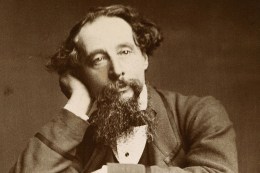
Original cabinet photograph of Charles Dickens
For the magazine this week, I wrote a piece about the legacy of Charles Dickens. He was a fascinating character on many fronts (Lev Grossman thought so too, after reading a couple of recent biographies), but what interests me, on the eve of his Feb. 7 bicentennial, is the way he helped make himself an enduring writer. I’m not just talking about writing great books; lots of people have done that. It’s that he took a vested interest in his legacy and in the legacy of the publishing industry overall, which is a large part of the reason we’re talking about him 200 years after he was born.
He was lucky in that his first novel, The Pickwick Papers, was a huge sensation. It tipped him and pretty much everyone around him off to the potential for boom times in fiction; that was apparent just by virtue of the imitators, acolytes and outright plagiarists his writing inspired. So it made sense that Dickens would do certain things to help keep himself at the forefront of the movement. He cultivated an exceedingly loyal audience, across class lines; he fought for copyright and collective bargaining powers for authors; he managed his posthumous reputation to the extent that he could control it, by burning all his letters and by appointing a very close friend as his first biographer; he edited two consecutive weekly magazines and fostered rising talent, thus creating a circle of admirers and protégés (while also, effectively, self-publishing his own work, in the serial format that his success with Pickwick had made the standard for the era).
(MORE: Six Ways to Celebrate Charles Dickens’ Bicentennial)
And he died while at the height of his creative powers. OK, maybe that wasn’t planned — and actually, reviewers at the time thought he’d gone creatively south a decade before, when his novels began to get progressively gloomier. Henry James wrote a particularly eviscerating review of Our Mutual Friend in 1865, which I quote in my piece. But the sprawling, dark novels of Dickens’ late period are exactly the ones that helped restore his reputation in the 20th century among critics and academics — two groups you need on your side if you’re going to pass the test of time.
So that’s what the magazine piece is about: how Dickens transformed what might otherwise have been ephemeral success into timelessness and why that matters now, during another boom time in literature brought about by the rise of electronic text.
What I’m planning to write about here, in the run-up to the bicentenary — is Dickens as a master stylist. He wrote 14 and a half novels (he died in the middle of The Mystery of Edwin Drood); I’ll rank the top 10. If you’ve read anything about Dickens, you’ve heard the critical commonplaces: his great sympathy for children, his angelic heroines, the way his serial composition lends itself so beautifully to television. All those things are true; as a graduate student and an occasional critic, I’ve written some of them myself. But in looking at his 10 best, I’ll focus on the quirks, the marginalia, the backstory and the language — all the tiny touches that make his work entertaining and inventive and special, two centuries on. Check back here on January 26 for the first installment.
LIST: The All-TIME 100 Novels

